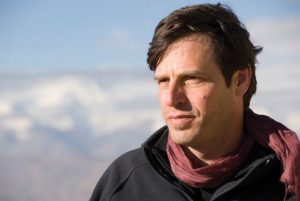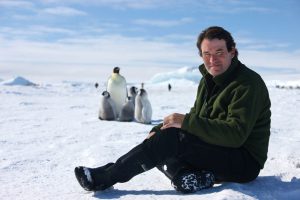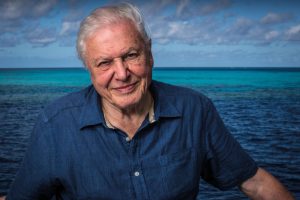
After more than 35 years of operation, TBI is closing its doors and our website will no longer be updated daily. Thank you for all of your support.
Blue chip to new chip: natural history with bite
 Stewart Clarke speaks to commissioners, producers, distributors and digital pioneers about their efforts to reimagine the natural history genre.
Stewart Clarke speaks to commissioners, producers, distributors and digital pioneers about their efforts to reimagine the natural history genre.
Alastair Fothergill is the embodiment of blue-chip, making landmark series for the BBC and films for Disney Nature, but he is now seeking to reinvent the genre, out of necessity as much as anything.
“When I came to the end of Frozen Planet I wondered if there was a habitat left we haven’t done?,” he says. “So I started to think about behavior.” The result is BBC and NDR series The Hunt, which looks at predators and prey in a new way. In terms of making the series, Fothergill says he was influenced by TV drama, and attempted to film some of the action as if it were a chase scene in a scripted series.
“The problem is there is an awful lot of very good natural history, and the audience has seen a lot, so [producers] need to enhance the experience,” he says. “But I’m not into experimenting for the sake of it, and I don’t want camera techniques to get between the viewer and the animals.”
 Anthony Geffen’s Atlantic’s Productions has been at the forefront of using new filming techniques and technology, from 3D to a recent push into virtual reality, but he echoes Fothergill’s sentiment. “You have to be careful with technology,” he says. “It is only good if it fits the narrative style – just finding and using a new camera is not enough.”
Anthony Geffen’s Atlantic’s Productions has been at the forefront of using new filming techniques and technology, from 3D to a recent push into virtual reality, but he echoes Fothergill’s sentiment. “You have to be careful with technology,” he says. “It is only good if it fits the narrative style – just finding and using a new camera is not enough.”
New tech and technical solutions, however, applied properly, can bring something new to the natural history genre. Wildlife producer Earth Touch tackled the perennial challenge of filming nocturnal animal behaviour in its series Hippos After Dark, which was recently picked up by Nat Geo Wild internationally.
“The challenge of filming at night has always been a daunting one,” says the indie’s creative director, Graeme Duane. “It is not only because of the obvious lack of light, but because of the lack of detail in any picture, and the myopia of being stuck in a dark, grainy space also weighs heavily on viewer tolerances.”
Earth Touch’s answer with Hippos was to add infrared light, 4K colouring and thermal imaging. “Using all of these bits of technology, which are merely adapted from readily-available commercial products, we’re building a view of the night that viewers haven’t seen before. Instead of grainy, spot-lit Blair Witch type images, we’re seeing some full-colour and high-action with a clean image, and a great sense of depth.”
Having benefitted from the move to high definition, producers and distributors are now pushing into ultra HD, or 4K, amid early talk of 8K. In terms of filmmaking, it means a return to classic, awe-inspiring docs that can portray the new standard on huge sets.
“The initial focus [for 4K] will be on showcasing the beauty and wonder of the world,” says Solange Attwood, senior VP at Canada-based producer and distributor Blue Ant Media. It recently set out to produce 200 hours of 4K content annually.
Blue Ant’s early offerings include 13x30mins The Big Feed about zoo animals, 3x60mins Land of Gremlins, about the wildlife of Madagascar, and 5x60mins Arctic Secrets, about the animals and plants of the Polar region.
The number of 4K customers is currently limited, but opening up, Attwood says. “A number of international buyers are interested in launching 4k channels and certainly, with the wider digital disruption in the industry, there is a lot of opportunity in VOD.”
Off The Fence is producing some of the 4K content for Blue Ant. Its distribution boss, Bo Stehmeier, says the HD-to-UHD transition is akin to the shift from SD-to-HD, but quicker. “It is very similar, but everything spins faster now,” he says. “When we first heard of ‘HD’ it was three years before we saw it. With ‘4K’ it will be eighteen months. Wildlife is perfect for 4K. At first the [shows] will be about the enjoyment of nature.
“If you are a content producer or distributor and can promise a supply of 4K, you can get a premium position because you have something that not many people can deliver.”
 With The Hunt, as well as shooting in 4K, Fothergill’s team also used new cameras to allow super-stable up-close footage that makes the viewer feel as if they are in the chase, without the isolating effect that results from some long lens shooting. Rethinking the audio was also key with Fothergill drafting in Steven Price, fresh from his Academy Award win for the Gravity score.
With The Hunt, as well as shooting in 4K, Fothergill’s team also used new cameras to allow super-stable up-close footage that makes the viewer feel as if they are in the chase, without the isolating effect that results from some long lens shooting. Rethinking the audio was also key with Fothergill drafting in Steven Price, fresh from his Academy Award win for the Gravity score.
“It’s not a traditional orchestral score and that reflects the new visual style,” says Fothergill. “We deliberately wanted to change things big-time with The Hunt. There is less orchestral sound and more playing with sound in a creative way. We put Steven with a dubbing editor from the Natural History Unit and he used sound effects as part of the score.”
Proving that innovation is not the preserve of the younger generation, Sir David Attenborough has been pushing the envelope in his shows with Atlantic. The UK prodco has forged a natural history pedigree through its shows with Attenborough, the best-known presenter in the genre, including a new three-parter, Attenborough’s Great Barrier Reef.
“When David and I got together ten productions ago, we talked about doing things in a different way,” says Atlantic’s Geffen. “The first thing we did [origins of life doc First Life] could have been just dusty rocks and fossils, but we used animation in an innovative way. Then we moved into stereoscopic 3D and David has embraced that too, as long as it is always driven by the story.”
The advent of new platforms, meanwhile, is changing the wider landscape. Netflix is following up Virunga, its Academy Award-nominated feature doc about park rangers in the titular Congolese national park, with more environment-themed fare, which will be made under the terms of a pact with Leonardo DiCaprio’s Appian Way prodco.
 SVOD services are not beholden to ratings and ad sales requirements, freeing them to pursue niche audiences and subjects. The growth of OTT will also, producers hope, help offset a dwindling numbers of free-to-air slots for natural history, a situation exacerbated by an increasing amount of drama in schedules as the genre basks in an ongoing golden age.
SVOD services are not beholden to ratings and ad sales requirements, freeing them to pursue niche audiences and subjects. The growth of OTT will also, producers hope, help offset a dwindling numbers of free-to-air slots for natural history, a situation exacerbated by an increasing amount of drama in schedules as the genre basks in an ongoing golden age.
“The production community is frustrated because scripted fills primetime, but as primetime moves that way, OTT platforms can re-open space for natural history,” says one European wildlife producer.
Off The Fence’s Stehmeier says: “Factual is produced for TV because TV is the main financier, but when you look at all of the narratives out there, you wonder if they need to be made into thirty- or sixty-minute shows. Maybe they could be condensed into 12 minutes, or could run longer. Linear commissions are thirty or sixty minutes because of advertising; in the future it will become more free-form, which will let the content breathe.”
Rich Ross, the former Shine US boss and now head of Discovery Channel in the States, also signalled a change in the direction of factual when he told journalists at the US winter press tour in January that it would stop ‘faking it’, meaning no more Mermaids: The Body Found or Megalodon: The Monster Shark Lives, which was part of the popular Shark Week event on Discovery. “I don’t think it’s right for Discovery Channel, and think it’s something that has run its course,” he said. “They’ve done very well, but I don’t think it’s something that’s right for us.”
Speaking about Eaten Alive, the failed stunt show in which a park ranger attempted to be swallowed by a snake on camera, he added: “I don’t believe you’ll see a person being eaten by a snake in my time.”
Discovery was, of course, not the only channel to use CGI to recreate mythical or long-extinct beasts with the likes of Walking with Dinosaurs having proved popular on the BBC and internationally. The trend didn’t sit well with everyone in the docs business.
“When the BBC was drawing dinosaurs I feel 90% of people thought dinosaurs were alive because it was hard to tell the difference between CGI and re-enactment,” says Esther van Messel, founder of European doc producer and distributor First Hand Films.
If the likes of Attenborough, Fothergill and Discovery are looking at new ways to present natural history, so are other producers that have not previously played in this space. “Most natural history is ‘factoid’; it is ‘here is a parakeet and here is its mating routine’, and beyond the context of ‘it’s from this part of the world’, there is no effort to do any narrative,” says World Media Rights CEO Alan Griffiths.
His indie prodco’s answer was to take its successful Black Ops military action doc series to the animal world Animal Black Ops will use the same drama reconstruction approach used in the original series to tell the story of animals preyed on by poachers, and law enforcement agencies efforts to capture them.
Animal Planet US has ordered a ten-part series and ITV Studios Global Entertainment has invested and taken international rights. “It’s an extension of the normal natural history genre, which is needed as it is a genre that hasn’t really moved on,” Griffiths says.
Meanwhile, the next frontier could be a virtual one. Atlantic has a big multiplatform, TV and virtual reality project in the works for 2016 although details are scant.
“It is the first of its kind, taking you on a journey that goes across different platforms – it is where the future of high-end is going,” Atlantic’s Geffen says. “We need new experiences that are very different, and VR is a whole new storytelling device.”
 Digital wildlife: from YouTube to television
Digital wildlife: from YouTube to television
Amid the talk of reinventing blue-chip and natural history, digital-savvy content companies are looking at how online platforms can be a low-cost seeding ground for a new form of wildlife show.
Barcroft Media is pioneering a model whereby content proves it has an audience on YouTube and is then developed into full-fledged series. The success of YouTube clips such as ‘snake devours crocodile’ (41 million views and counting) and ‘flying lion’ (currently at 48 million views) on YouTube channel Barcroft TV illustrate the demand. The net recently hit the one-million subs mark.
“The traditional BBC [natural history] over the last few years has been exhaustive and amazing, but has run its course with some viewers; there is a little weariness,” Barcroft founder Sam Barcroft says. “If you look at how people want to consume, and what it is they want to know, you will see they are fascinated by conflict in the animal kingdom, and those [clips] feel super authentic.”
The voyeuristic excitement of watching UGC resonates particularly with a young male demo, which is increasingly hard to reach on TV. The other area Barcroft pinpoints is human stories about people that have strong connections with animals – such as the ‘man who can swim with a polar bear’ (31 million views and used in Google’s own review of the year). The success of the polar bear clip led to a series commission for Preposterous Pets from Discovery’s international Animal Planet channel. The aforementioned flying lion clip proved the jumping off point for viral video show Chaos Caught on Camera, greenlit by Discovery and debuting on its Science Channel in April.
 Moving from YouTube to linear, however, involves more than just repackaging clips, Barcroft says. “You need to take a novel approach and integrate pop science and other elements to decode what has been taken from online.”
Moving from YouTube to linear, however, involves more than just repackaging clips, Barcroft says. “You need to take a novel approach and integrate pop science and other elements to decode what has been taken from online.”
Barcroft is also now producing longer-form online content that will debut on YouTube and will then, it hopes, be acquired for television. The first of these self-funded projects includes shark series Landing Sharks.
Phil Craig talks new chip
Ex-Nutopia and ABC Australia executive Phil Craig started in his new role as executive VP and chief creative officer at Discovery in March, unveiling his first five-strong slate of programmes soon after.
The quintet included Discovery’s first solo effort in natural history. “We hadn’t commissioned natural history before, but it is a genre we know people love and we have now greenlit one show and are looking for more,” he says. “It is important that we do that and see DNI establish itself as a home for natural history.”
 Discovery’s requirements in this area are exacerbated by the end of a deal with the BBC that saw it invest alongside the UK pubcaster in blue-chip series including Life and Blue Planet. Dubbing DNI’s new approach ‘new chip’, Craig says that, ultimately, it can match its former partner’s efforts in this area: “In the future, there is no reason we can’t even rival the BBC,” he says.
Discovery’s requirements in this area are exacerbated by the end of a deal with the BBC that saw it invest alongside the UK pubcaster in blue-chip series including Life and Blue Planet. Dubbing DNI’s new approach ‘new chip’, Craig says that, ultimately, it can match its former partner’s efforts in this area: “In the future, there is no reason we can’t even rival the BBC,” he says.
The first natural history commission is Life of Dogs (WT). Grant Mansfield’s Plimsoll Productions is making the canine-themed series, which will debut next year. Using a ‘unique blending of traditional blue chip natural history with a new style of immersive, revelatory, storytelling’ it will look at the history of dogs and their close relationship with man. “It is about the evolution of two species and will be beautiful and inspiring,” says Craig.
It is a ‘new chip’ show, he adds, which means bringing an energised popular style to factual filmmaking. US content chief Ross has spoken about Discovery Channel returning to core values, but that doesn’t mean a return to old production styles, according to Craig. He wants the production community to help him to further define ‘new chip’, but expects shows in this category to be both authentic and entertaining.
“It is about programming with a sense of purpose and inspiration,” he says. “When people come to a Discovery show they should expect to be entertained; we’re not selling homework, and we operate in a competitive environment,” he says.
In natural history terms, new chip means beautifully shot shows, but with added components. “There is no shortage of beautiful images of animals, but there is a shortage of storytellers,” Craig says. “The tendency has been to lapse into a survey style. We want to work with natural history filmmakers that tell stories in the same way as you’d expect with drama. You might draw people in for four or five minutes with beautiful wildlife, but to keep viewers you need to surprise them and offer first class storytelling.”
Discovery’s first choice will still be to fully fund and take all rights, although the new Discovery exec says it will now keep an open mind if partners are already attached, with several possible copros currently on his desk. That’s another sign of change in the factual business.


